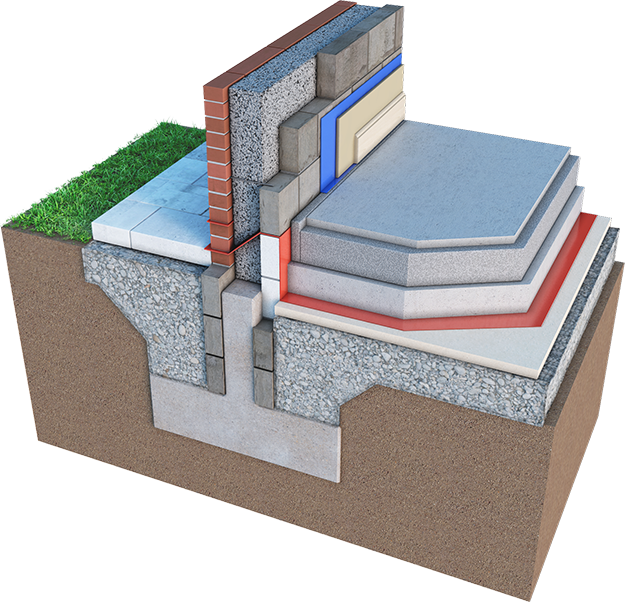Cavity Wall insulation is one of the simplest and most cost-effective ways to insulate a home in order to save money and improve your comfort by making it more energy efficient.
The average home can lose as much as much as 30% of its heat through its external walls, making cavity wall insulation an ideal way to reduce heat loss.
Cavity wall insulation installed also leaves your home visually unchanged, having no affect on its appearance.

The key takeaways:
Table of Content
What is a cavity wall?
A Cavity Wall, as opposed to solid walls, are external walls of a building which have an empty cavity space between the inner and outer walls. The purpose of this wall cavity is to allow for water to drain from the base of the wall. It also creates a slow-moving air gap between the walls to reduce heat loss.
The inner and outer wall are known as the leaves of the cavity wall, with wall ties connecting the inner and outer wall in order to provide structural integrity. The majority of houses built in Ireland after the 1940s have been built with cavity walls.
What is cavity wall insulation?
Cavity Wall Insulation refers to any insulation material which is installed in the space between the inner and outer walls of a cavity walls to reduce further the amount of heat lost through the walls by trapping air from circulating.
It can also have other benefits such as preventing dampness, improving the structural integrity of the wall, and providing sound insulation so that less noise gets in from outside.
The effectiveness of cavity wall insulation is measured by its U-value, which tells how much heat will pass through the insulation. The lower the U-value of your insulation, which is measured in W/m²K, the better its performance will be.
Types of Cavity Wall Insulation
There are two main varieties of Cavity Wall Insulation: Pumped Insulation and Solid |nsulation Boards or Rolls. The type of insulation material best suited to your house will depend on whether it is a new build or retrofit project. Pumped insulation is typically more suited to retrofit project, as there is minimal interference with the fabric of cavity wall.
The main varieties of insulation materials used on cavity walls are:
How much does cavity wall insulation cost?
The cost of having cavity wall insulation installed will vary from project to project based on multiple factors related to the property, materials, and installation work.
When looking at the cost of insulation the main factors to keep in mind are:
The larger amount of surface area your home has, the larger the cost of the project will be. This is also true of how wide the cavity gap in your home is, something which will need to be assessed and measured before work can begin.
Of the two main types of insulation used in these projects, Polyurethane Spray Foam insulation typically costs more per m² than Polystyrene Bonded Bead insulation.
Some rough cost estimates for cavity wall insulation in Ireland would be:
Detached properties will need to be surveyed in order to give an accurate assessment. These are only rough estimates, and a proper pricing will vary based on the factors mentioned above.
For new builds, other options such as Polystyrene Boards and Mineral Wool might seem cheaper upfront. However, they will likely not have the same thermal performance at the same thickness.
Cavity Wall Insulation Grants
The SEAI offers grant funding for almost all homeowners to help with the cost of having cavity wall insulation installed in their houses or apartments.
The grant is available to all homeowners, including private landlords, so long as the property was built and occupied before 2011.
| Insulation Type | Grant Value |
| Cavity Wall Insulation | Apartment (Any) – €700 Mid-Terrace House – €800 Semi-Detached/End-Terrace – €1,200 Detached House – €1,700 |
Cavity Wall Insulation Benefits
Having cavity wall insulation on your home can create big improvements in your quality of life, as well as financial gains from the improvements to the property.

Cavity Wall Insulation Installation
- An Assessment will be carried out on-site to measure the available space in the cavity walls and check for any existing problems with dampness.
- Holes are drilled in the cavity wall from the outside in a pattern which ensures that all areas of the wall will be filled, without any blank spots which would undermine the performance of the insulation.
- The insulation is injected into the cavity walls at high pressure using compressed air until all areas of the wall have been filled.
- The holes are then filled in with mortar and matched with the existing surface of the cavity walls to reduce the visual effect.
Note: If you live in an apartment, terraced house, or semi-detached house steps will also be taken to ensure no work encroaches on neighbouring properties.
One advantage of Cavity Wall Insulation is that almost all the work is carried out on the outside of the property. This means that there will be minimal disruption to the homeowner while the work is being carried out.
FAQs
Get a quote for your home’s cavity wall insulation today
If you are interested in improving your home’s efficiency with cavity wall insulation, speak to the experts at Energy Efficiency today!
Make an enquiry today for a FREE consultation and get the best quotes on the market tailored to you.
Find out why we are Ireland’s leading source of home energy and efficiency information.



